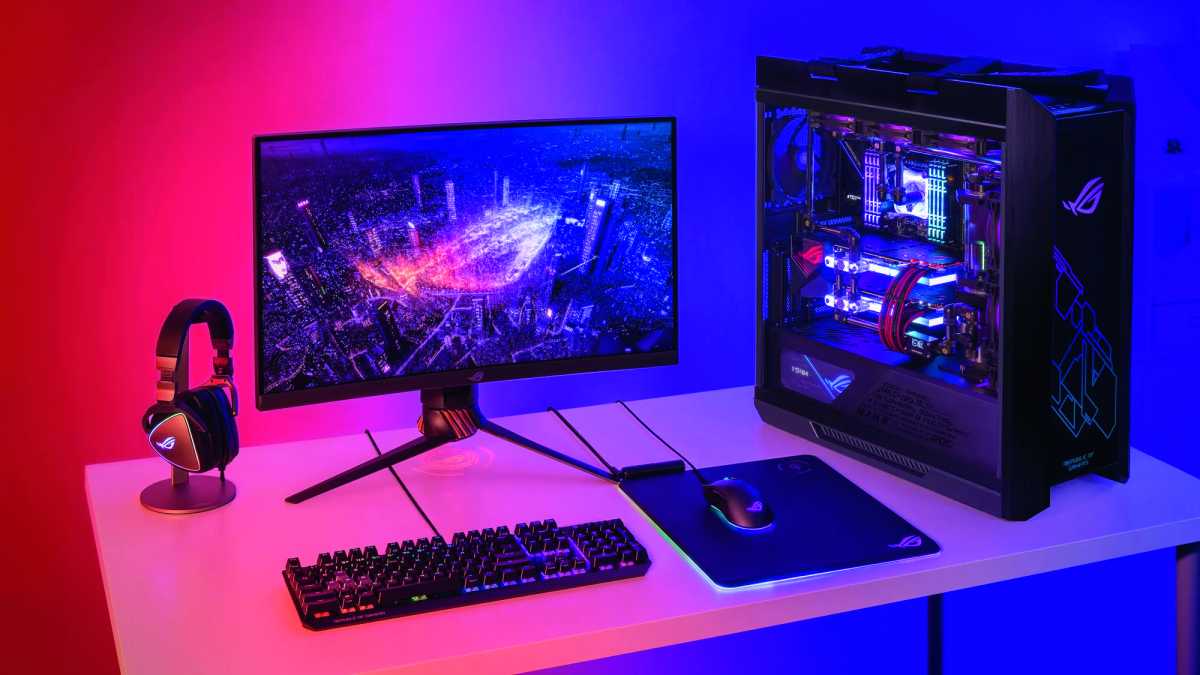Energy-Efficient Desktop Computers For Eco-Friendly Users

In a world where technology is constantly evolving and our environmental impact is more important than ever, eco-conscious consumers are seeking energy-efficient options for their everyday devices. One area where this is particularly crucial is in the realm of desktop computers. As we spend more time working and playing on our computers, the energy consumption of these devices becomes a significant factor in our overall carbon footprint. Fortunately, there are a variety of energy-efficient desktop computers on the market that cater to the eco-friendly user. From sleek, minimalist designs to high-performance machines, these options offer a sustainable solution without compromising on power and functionality. Let’s explore the world of energy-efficient desktop computers and discover how they can make a positive impact on both our daily lives and the environment.
Related: Buy Best Desktops in Oman
Energy-Efficient Desktop Computers: A Sustainable Choice for the Environmentally Conscious Individual
When it comes to reducing our carbon footprint and preserving the environment, every small step counts. As an environmentally conscious individual, choosing energy-efficient desktop computers is a sustainable choice that can make a significant impact. These eco-friendly devices are designed to minimize energy consumption without compromising on performance, making them the perfect choice for both personal and professional use.
Energy-efficient desktop computers offer several benefits for eco-friendly users:
- Reduced Energy Consumption: Unlike traditional computers, energy-efficient models are designed to consume less power, helping to lower electricity bills and overall energy consumption.
- Longer Lifespan: By using advanced technologies and components, energy-efficient desktop computers are built to last longer. This means fewer replacements and less electronic waste, contributing to a more sustainable future.
- Eco-Friendly Materials: Many energy-efficient desktop computers are made from recycled or sustainable materials, reducing the demand for new resources and minimizing the environmental impact of their production.
- Environmentally Friendly Packaging: In addition to the eco-friendly design of the computers themselves, manufacturers often prioritize sustainable packaging to further reduce waste and carbon emissions.
Investing in an energy-efficient desktop computer not only benefits the environment but also provides a more efficient and reliable computing experience. With a wide range of options available in the market, it’s easier than ever to make a sustainable choice without compromising on performance or functionality.
Unveiling the Inner Workings of Energy-Efficient Desktop Computers: How They Minimize Energy Consumption
Energy-efficient desktop computers are becoming increasingly popular among eco-conscious consumers. These innovative devices are designed to minimize energy consumption, making them a greener and more sustainable choice for those looking to reduce their carbon footprint. But how exactly do these computers work to minimize energy usage?
One key feature of energy-efficient desktop computers is their use of advanced power management technologies. These technologies allow the computer to automatically adjust its power usage based on the current workload. For example, when the computer is idle or running light tasks, it will reduce the power consumption of its components, such as the CPU and GPU. This not only saves energy but also helps to extend the lifespan of the components, reducing the need for frequent replacements.
Another important aspect of energy-efficient desktop computers is their use of low-power components. These components are specifically designed to consume less energy without compromising performance. For example, energy-efficient processors are designed to deliver the same level of performance as traditional processors while using significantly less power. Similarly, low-power graphics cards and solid-state drives (SSDs) are used to further minimize energy consumption. In addition, energy-efficient desktop computers often come with power-saving features such as automatic sleep modes and power-off timers, which help to further reduce energy usage when the computer is not in use.
In summary, energy-efficient desktop computers are a great choice for eco-friendly users who want to minimize their energy consumption. With advanced power management technologies and low-power components, these computers are able to deliver the same level of performance as traditional desktops while using significantly less energy. By choosing an energy-efficient desktop computer, you can not only reduce your carbon footprint but also save on energy costs in the long run.
Finding the Perfect Fit: Recommendations for Energy-Efficient Desktop Computers
Energy efficiency has become a top priority for eco-conscious users, and when it comes to desktop computers, there are plenty of options to choose from. Whether you’re a professional seeking a powerful workstation or a casual user looking for everyday computing, there is a perfect fit for everyone. Here are some recommendations for energy-efficient desktop computers that will not only help you save on electricity bills but also reduce your carbon footprint.
- Apple iMac: Known for its sleek design and powerful performance, the Apple iMac is also an energy-efficient choice. With its advanced hardware and optimized software, it delivers exceptional performance while consuming less power. The iMac uses energy-saving technologies like LED backlighting, low-power processors, and automatic power management to ensure maximum efficiency.
- Dell OptiPlex: If you’re looking for a reliable and energy-efficient desktop computer for your office or home, the Dell OptiPlex series is worth considering. These compact and customizable computers are designed to meet the needs of businesses and individuals alike. Equipped with energy-efficient components, such as Intel processors and solid-state drives, the OptiPlex series offers excellent performance with reduced power consumption.
In addition to these recommendations, it’s important to consider other factors when choosing an energy-efficient desktop computer. Look for computers that are ENERGY STAR certified, as they meet strict energy efficiency guidelines set by the Environmental Protection Agency (EPA). Consider the power requirements of the computer, as well as its overall performance and features, to find the perfect fit for your eco-friendly lifestyle.
[Table]| Brand | Model | Power Consumption (Watt) |
|---|---|---|
| Apple | iMac | 60-200 |
| Dell | OptiPlex | 40-150 |
| HP | Pavilion | 50-180 |
| Lenovo | ThinkCentre | 30-120 |
| ASUS | VivoPC | 20-100 |
Remember, energy-efficient desktop computers not only help you save money but also contribute to a greener environment. By making a conscious choice, you can enjoy the benefits of cutting-edge technology while reducing your impact on the planet. So go ahead, choose a desktop computer that aligns with your eco-friendly values and enjoy a more sustainable computing experience.
Maximizing Eco-Friendly Computing: Tips and Tricks to Optimize Energy Efficiency
As eco-conscious individuals, it is important for us to consider the environmental impact of our computing habits. One way to contribute to a sustainable future is by choosing energy-efficient desktop computers. These devices are specifically designed to optimize energy consumption, reducing both our carbon footprint and electricity bills. Here are some tips and tricks to help you maximize eco-friendly computing with energy-efficient desktop computers:
1. Select Energy Star Certified Models
When purchasing a desktop computer, look for models that are Energy Star certified. These computers meet strict energy efficiency guidelines set by the Environmental Protection Agency (EPA). Energy Star certified devices consume less power during use, sleep, and idle modes, making them an excellent choice for eco-friendly users. Look for the Energy Star logo or check the manufacturer’s specifications to ensure you are selecting an energy-efficient desktop computer.
2. Optimize Power Management Settings
Take advantage of the power management settings available on your desktop computer. Adjusting these settings allows you to optimize energy efficiency by reducing power consumption when the computer is not in use. Consider enabling features such as automatic sleep mode, which puts the computer into a low-power state after a specified period of inactivity. Additionally, adjust the screen brightness and set shorter display sleep times to conserve energy. These simple tweaks can have a significant impact on reducing energy usage without compromising performance.
| Energy-Saving Tips | Impact |
|---|---|
| Unplug peripherals when not in use | Reduces standby power consumption |
| Use a smart power strip | Cuts off power to peripherals when the computer is turned off |
| Upgrade to solid-state drives (SSDs) | Decreases energy consumption compared to traditional hard drives |
By implementing these tips and utilizing energy-efficient desktop computers, we can make a positive impact on the environment while still enjoying the benefits of modern technology. Let’s strive for a greener future through eco-friendly computing!
In Conclusion
In conclusion, choosing an energy-efficient desktop computer is not only beneficial for the environment, but also for your wallet. By opting for eco-friendly technology, you can reduce your carbon footprint and contribute to a more sustainable future. With a wide range of options available on the market, it’s easier than ever to find a desktop computer that meets your computing needs while also being environmentally conscious. So, make the switch today and do your part in preserving the planet for future generations. Thank you for reading and happy computing!



